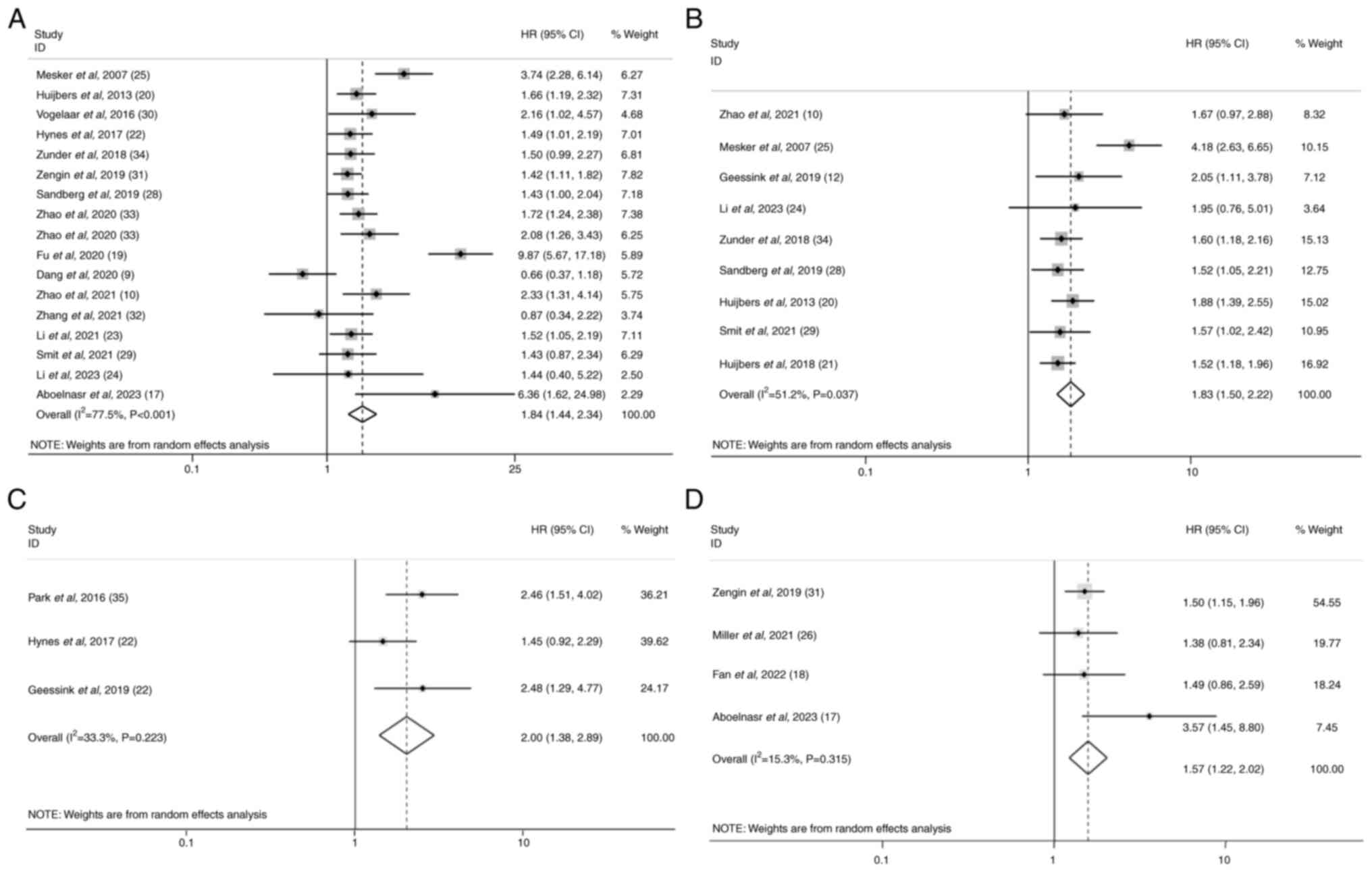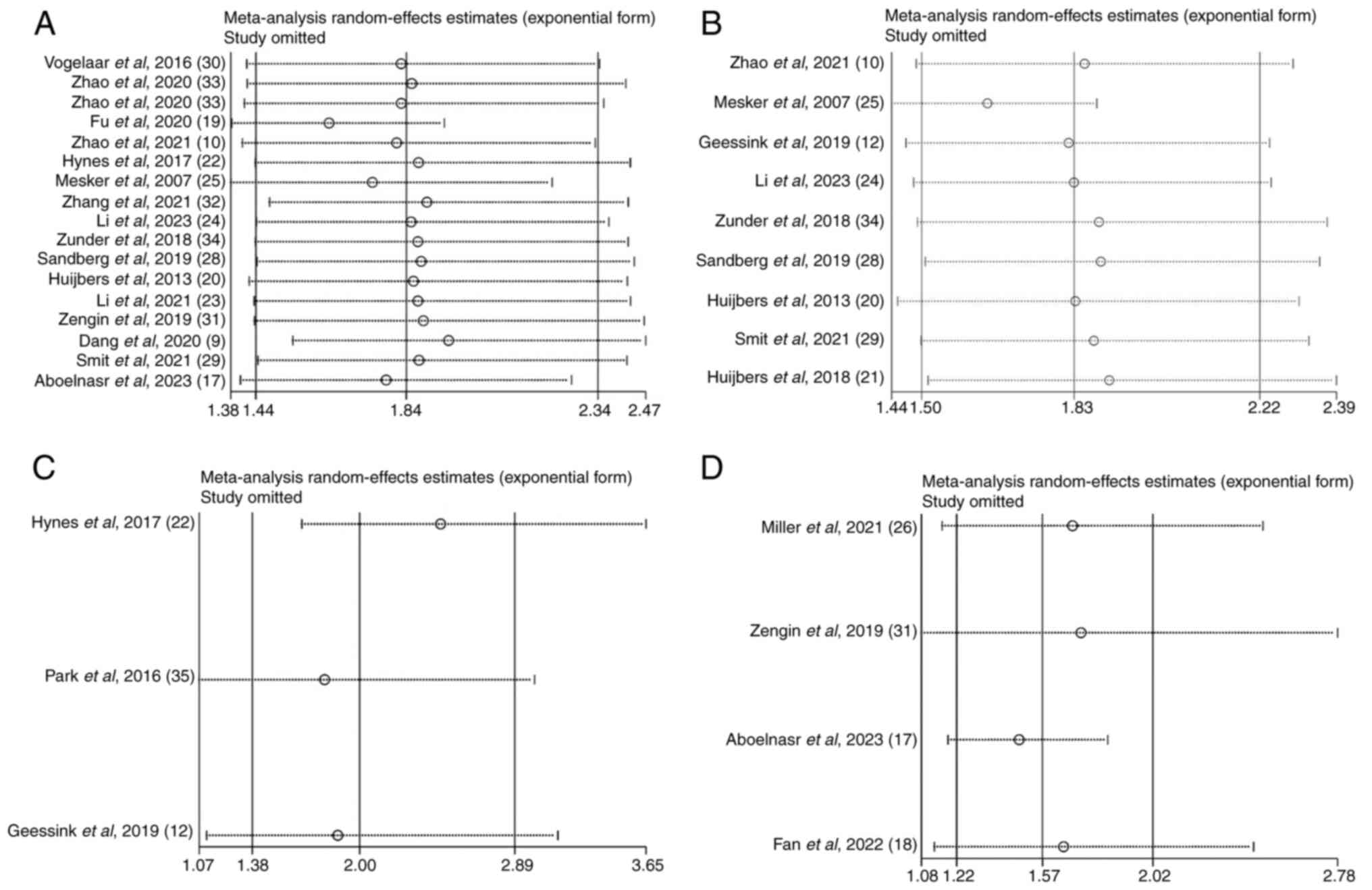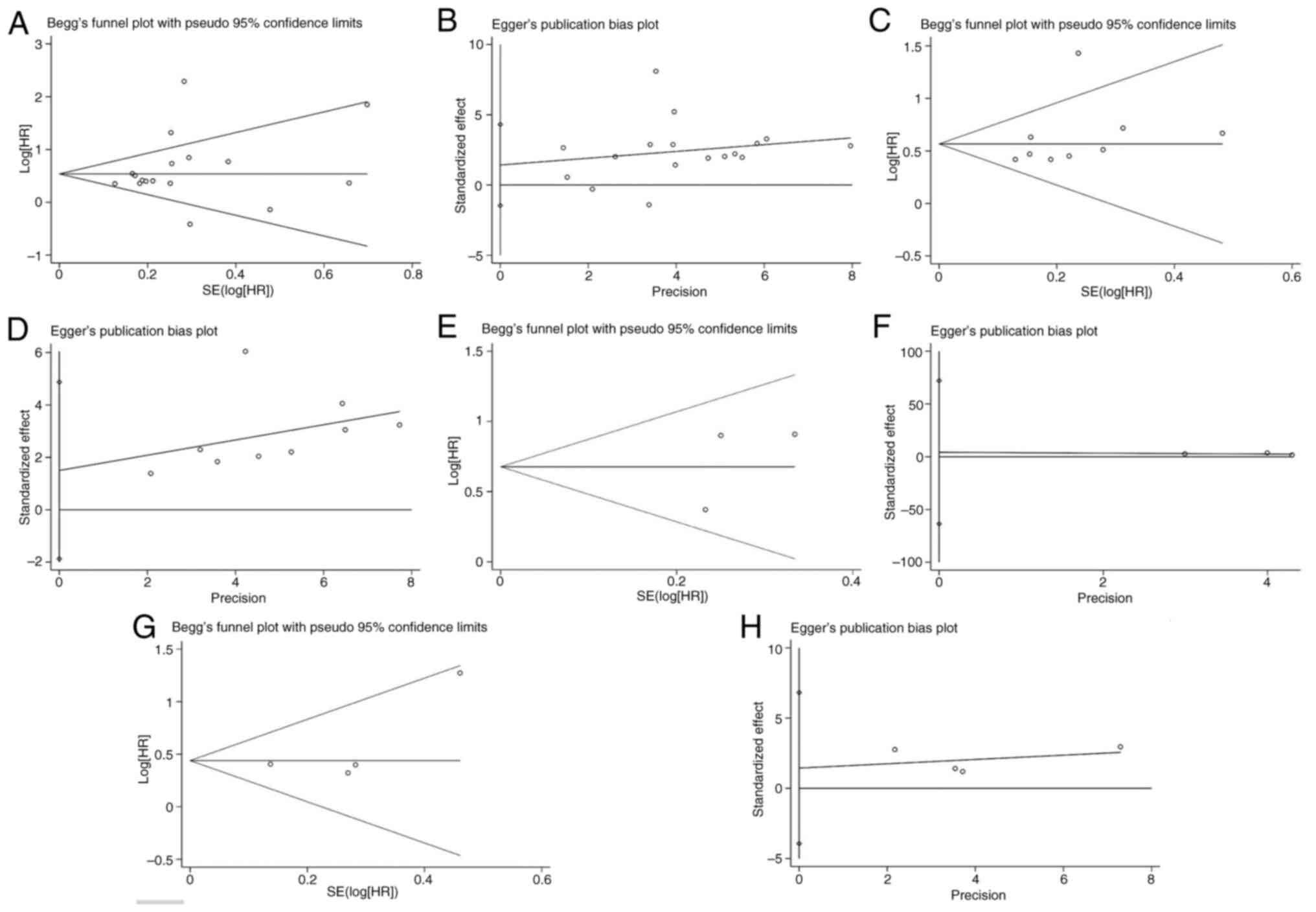|
1
|
Jiao S, Li C, Hao Q, Miao H, Zhang L, Li L
and Zhou Z: VGLL4 targets a TCF4-TEAD4 complex to coregulate Wnt
and Hippo signalling in colorectal cancer. Nat Commun. 8:140582017.
View Article : Google Scholar : PubMed/NCBI
|
|
2
|
Araghi M, Soerjomataram I, Jenkins M,
Brierley J, Morris E, Bray F and Arnold M: Global trends in
colorectal cancer mortality: Projections to the year 2035. Int J
Cancer. 144:2992–3000. 2019. View Article : Google Scholar : PubMed/NCBI
|
|
3
|
Yang K, Gao K, Hu G, Wen Y, Lin C and Li
X: CTGF enhances resistance to 5-FU-mediating cell apoptosis
through FAK/MEK/ERK signal pathway in colorectal cancer. Onco
Targets Ther. 9:7285–7295. 2016. View Article : Google Scholar : PubMed/NCBI
|
|
4
|
Crawford N, Salvucci M, Hellwig CT,
Lincoln FA, Mooney RE, O'Connor CL, Prehn JH, Longley DB and Rehm
M: Simulating and predicting cellular and in vivo responses of
colon cancer to combined treatment with chemotherapy and IAP
antagonist Birinapant/TL32711. Cell Death Differ. 25:1952–1466.
2018. View Article : Google Scholar : PubMed/NCBI
|
|
5
|
Benson AB, Venook AP, Al-Hawary MM, Arain
MA, Chen YJ, Ciombor KK, Cohen S, Cooper HS, Deming D, Farkas L, et
al: Colon Cancer, Version 2.2021, NCCN clinical practice guidelines
in oncology. J Natl Compr Canc Netw. 19:329–359. 2021. View Article : Google Scholar : PubMed/NCBI
|
|
6
|
Langley RR and Fidler IJ: The seed and
soil hypothesis revisited-the role of tumor-stroma interactions in
metastasis to different organs. Int J Cancer. 128:2527–2535. 2011.
View Article : Google Scholar : PubMed/NCBI
|
|
7
|
Pietras K and Ostman A: Hallmarks of
cancer: Interactions with the tumor stroma. Exp Cell Res.
316:1324–1331. 2010. View Article : Google Scholar : PubMed/NCBI
|
|
8
|
Quail DF and Joyce JA: Microenvironmental
regulation of tumor progression and metastasis. Nat Med.
19:1423–1437. 2013. View
Article : Google Scholar : PubMed/NCBI
|
|
9
|
Dang H, van Pelt GW, Haasnoot KJC, Backes
Y, Elias SG, Seerden TCJ, Schwartz MP, Spanier BWM, de Vos Tot
Nederveen Cappel WH, van Bergeijk JD, et al: Tumour-stroma ratio
has poor prognostic value in non-pedunculated T1 colorectal cancer:
A multi-centre case-cohort study. United European Gastroenterol J.
9:20506406209753242020.PubMed/NCBI
|
|
10
|
Zhao Z, Zhang X, Li Z, Gao Y, Guan X,
Jiang Z, Liu Z, Yang M, Chen H, Ma X, et al: Automated assessment
of DNA ploidy, chromatin organization, and stroma fraction to
predict prognosis and adjuvant therapy response in patients with
stage II colorectal carcinoma. Am J Cancer Res. 11:6119–6132.
2021.PubMed/NCBI
|
|
11
|
Zhang R, Song W, Wang K and Zou S:
Tumor-stroma ratio (TSR) as a potential novel predictor of
prognosis in digestive system cancers: A meta-analysis. Clin Chim
Acta. 472:64–68. 2017. View Article : Google Scholar : PubMed/NCBI
|
|
12
|
Geessink OGF, Baidoshvili A, Klaase JM,
Ehteshami Bejnordi B, Litjens GJS, van Pelt GW, Mesker WE,
Nagtegaal ID, Ciompi F and van der Laak JAWM: Computer aided
quantification of intratumoral stroma yields an independent
prognosticator in rectal cancer. Cell Oncol (Dordr). 42:331–341.
2019. View Article : Google Scholar : PubMed/NCBI
|
|
13
|
Moher D, Shamseer L, Clarke M, Ghersi D,
Liberati A, Petticrew M, Shekelle P and Stewart LA; PRISMA-P Group,
: Preferred reporting items for systematic review and meta-analysis
protocols (PRISMA-P) 2015 statement. Syst Rev. 4:12015. View Article : Google Scholar : PubMed/NCBI
|
|
14
|
Parmar MK, Torri V and Stewart L:
Extracting summary statistics to perform meta-analyses of the
published literature for survival endpoints. Stat Med.
17:2815–2834. 1998. View Article : Google Scholar : PubMed/NCBI
|
|
15
|
Jayaraj R, Kumarasamy C, Sabarimurugan S
and Baxi S: Diagnostic and prognostic value of microRNAs for
cancers-strategies and approaches to improve the clinical utility.
J Cancer. 10:1252–1253. 2019. View Article : Google Scholar : PubMed/NCBI
|
|
16
|
DerSimonian R and Laird N: Meta-analysis
in clinical trials. Control Clin Trials. 7:177–188. 1986.
View Article : Google Scholar : PubMed/NCBI
|
|
17
|
Aboelnasr LS, El-Rebey HS, Mohamed A and
Abdou AG: The prognostic impact of tumor border configuration,
tumor budding and tumor stroma ratio in colorectal carcinoma. Turk
Patoloji Derg. 39:83–93. 2023.PubMed/NCBI
|
|
18
|
Fan S, Cui X and Zheng L: Prognostic value
of desmoplastic stromal reaction, tumor budding and tumor-stroma
ratio in stage II colorectal cancer. J Gastrointest Oncol.
13:2903–2921. 2022. View Article : Google Scholar : PubMed/NCBI
|
|
19
|
Fu M, Chen D, Luo F, Li M, Wang Y, Chen J,
Li A and Liu S: Association of the tumour stroma percentage in the
preoperative biopsies with lymph node metastasis in colorectal
cancer. Br J Cancer. 122:388–396. 2020. View Article : Google Scholar : PubMed/NCBI
|
|
20
|
Huijbers A, Tollenaar RA, v Pelt GW,
Zeestraten EC, Dutton S, McConkey CC, Domingo E, Smit VT, Midgley
R, Warren BF, et al: The proportion of tumor-stroma as a strong
prognosticator for stage II and III colon cancer patients:
Validation in the VICTOR trial. Ann Oncol. 24:179–185. 2013.
View Article : Google Scholar : PubMed/NCBI
|
|
21
|
Huijbers A, van Pelt GW, Kerr RS,
Johnstone EC, Tollenaar RAEM, Kerr DJ and Mesker WE: The value of
additional bevacizumab in patients with high-risk stroma-high colon
cancer. A study within the QUASAR2 trial, an open-label randomized
phase 3 trial. J Surg Oncol. 117:1043–1048. 2018. View Article : Google Scholar : PubMed/NCBI
|
|
22
|
Hynes SO, Coleman HG, Kelly PJ, Irwin S,
O'Neill RF, Gray RT, McGready C, Dunne PD, McQuaid S, James JA, et
al: Back to the future: Routine morphological assessment of the
tumour microenvironment is prognostic in stage II/III colon cancer
in a large population-based study. Histopathology. 71:12–26. 2017.
View Article : Google Scholar : PubMed/NCBI
|
|
23
|
Li T, Yu Z, Yang Y, Fu Z, Chen Z, Li Q,
Zhang K, Luo Z, Qiu Z and Huang C: Rapid multi-dynamic algorithm
for gray image analysis of the stroma percentage on colorectal
cancer. J Cancer. 12:4561–4573. 2021. View Article : Google Scholar : PubMed/NCBI
|
|
24
|
Li Y, Liao L, Kong L, Jiang W, Tang J, Han
K, Hou Z, Zhang C, Zhou C, Zhang L, et al: DNA ploidy and stroma
predicted the risk of recurrence in low-risk stage III colorectal
cancer. Clin Transl Oncol. 25:218–225. 2023. View Article : Google Scholar : PubMed/NCBI
|
|
25
|
Mesker WE, Junggeburt JM, Szuhai K, de
Heer P, Morreau H, Tanke HJ and Tollenaar RA: The carcinoma-stromal
ratio of colon carcinoma is an independent factor for survival
compared to lymph node status and tumor stage. Cell Oncol.
29:387–398. 2007.PubMed/NCBI
|
|
26
|
Miller S, Bauer S, Schrempf M, Schenkirsch
G, Probst A, Märkl B and Martin B: Semiautomatic analysis of tumor
proportion in colon cancer: Lessons from a validation study. Pathol
Res Pract. 227:1536342021. View Article : Google Scholar : PubMed/NCBI
|
|
27
|
Park JH, McMillan DC, Edwards J, Horgan PG
and Roxburgh CS: Comparison of the prognostic value of measures of
the tumor inflammatory cell infiltrate and tumor-associated stroma
in patients with primary operable colorectal cancer.
Oncoimmunology. 5:e10988012016. View Article : Google Scholar : PubMed/NCBI
|
|
28
|
Sandberg TP, Sweere I, van Pelt GW, Putter
H, Vermeulen L, Kuppen PJ, Tollenaar RAEM and Mesker WE: Prognostic
value of low CDX2 expression in colorectal cancers with a high
stromal content-a short report. Cell Oncol (Dordr). 42:397–403.
2019. View Article : Google Scholar : PubMed/NCBI
|
|
29
|
Smit MA, van Pelt GW, Terpstra V, Putter
H, Tollenaar RAEM, Mesker WE and van Krieken JHJM: Tumour-stroma
ratio outperforms tumour budding as biomarker in colon cancer: A
cohort study. Int J Colorectal Dis. 36:2729–2737. 2021. View Article : Google Scholar : PubMed/NCBI
|
|
30
|
Vogelaar FJ, van Pelt GW, van Leeuwen AM,
Willems JM, Tollenaar RA, Liefers GJ and Mesker WE: Are
disseminated tumor cells in bone marrow and tumor-stroma ratio
clinically applicable for patients undergoing surgical resection of
primary colorectal cancer? The Leiden MRD study. Cell Oncol
(Dordr). 39:537–544. 2016. View Article : Google Scholar : PubMed/NCBI
|
|
31
|
Zengin M: Tumour budding and tumour stroma
ratio are reliable predictors for death and recurrence in elderly
stage I colon cancer patients. Pathol Res Pract. 215:1526352019.
View Article : Google Scholar : PubMed/NCBI
|
|
32
|
Zhang Y, Liu Y, Qiu X and Yan B:
Concurrent comparison of the prognostic values of tumor budding,
tumor stroma ratio, tumor infiltrating pattern and
Lymphocyte-to-Monocyte ratio in colorectal cancer patients. Technol
Cancer Res Treat. 20:153303382110458262021. View Article : Google Scholar : PubMed/NCBI
|
|
33
|
Zhao K, Li Z, Yao S, Wang Y, Wu X, Xu Z,
Wu L, Huang Y, Liang C and Liu Z: Artificial intelligence
quantified tumour-stroma ratio is an independent predictor for
overall survival in resectable colorectal cancer. EBioMedicine.
61:1030542020. View Article : Google Scholar : PubMed/NCBI
|
|
34
|
Zunder SM, van Pelt GW, Gelderblom HJ,
Mancao C, Putter H, Tollenaar RA and Mesker WE: Predictive
potential of tumour-stroma ratio on benefit from adjuvant
bevacizumab in high-risk stage II and stage III colon cancer. Br J
Cancer. 119:164–169. 2018. View Article : Google Scholar : PubMed/NCBI
|
|
35
|
van Pelt GW, Kjær-Frifeldt S, van Krieken
JHJM, Al Dieri R, Morreau H, Tollenaar RAEM, Sørensen FB and Mesker
WE: Scoring the tumor-stroma ratio in colon cancer: Procedure and
recommendations. Virchows Arch. 473:405–412. 2018. View Article : Google Scholar : PubMed/NCBI
|
|
36
|
Ehteshami Bejnordi B, Veta M, Johannes van
Diest P, van Ginneken B, Karssemeijer N, Litjens G, van der Laak
JAWM; the CAMELYON16 Consortium, ; Hermsen M, Manson QF, et al:
diagnostic assessment of deep learning algorithms for detection of
lymph node metastases in women with breast cancer. JAMA.
318:2199–2210. 2017. View Article : Google Scholar : PubMed/NCBI
|
|
37
|
Wang M, Zhao J, Zhang L, Wei F, Lian Y, Wu
Y, Gong Z, Zhang S, Zhou J, Cao K, et al: Role of tumor
microenvironment in tumorigenesis. J Cancer. 8:761–773. 2017.
View Article : Google Scholar : PubMed/NCBI
|
|
38
|
Elinav E, Nowarski R, Thaiss CA, Hu B, Jin
C and Flavell RA: Inflammation-induced cancer: Crosstalk between
tumours, immune cells and microorganisms. Nat Rev Cancer.
13:759–771. 2013. View Article : Google Scholar : PubMed/NCBI
|
|
39
|
Arneth B: Tumor Microenvironment. Medicina
(Kaunas). 56:152019. View Article : Google Scholar : PubMed/NCBI
|
|
40
|
Almangush A, Alabi RO, Troiano G, Coletta
RD, Salo T, Pirinen M, Mäkitie AA and Leivo I: Clinical
significance of tumor-stroma ratio in head and neck cancer: A
systematic review and meta-analysis. BMC Cancer. 21:4802021.
View Article : Google Scholar : PubMed/NCBI
|
|
41
|
Jiang P, Chen Y and Liu B: Prognostic
efficacy of tumor-stroma ratio in women with breast cancer: A
Meta-analysis of cohort studies. Front Oncol. 11:7314092021.
View Article : Google Scholar : PubMed/NCBI
|
|
42
|
Zhang X, Ma H, Zhang L and Li F:
Predictive role of Tumor-stroma ratio for survival of patients with
Non-small cell lung cancer: A Meta-analysis. Pathol Oncol Res.
27:16100212021. View Article : Google Scholar : PubMed/NCBI
|
|
43
|
Zhu Y, Jin Z, Qian Y, Shen Y and Wang Z:
Prognostic value of tumor-stroma ratio in rectal cancer: A
systematic review and Meta-analysis. Front Oncol. 11:6855702021.
View Article : Google Scholar : PubMed/NCBI
|
|
44
|
Gao J, Shen Z, Deng Z and Mei L: Impact of
Tumor-stroma ratio on the prognosis of colorectal cancer: A
systematic review. Front Oncol. 11:7380802021. View Article : Google Scholar : PubMed/NCBI
|
|
45
|
Sullivan L, Pacheco RR, Kmeid M, Chen A
and Lee H: Tumor stroma ratio and its significance in locally
advanced colorectal cancer. Curr Oncol. 29:3232–3241. 2022.
View Article : Google Scholar : PubMed/NCBI
|














